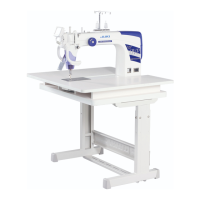
 Loading...
Loading...
Do you have a question about the JUKI J-350QVP and is the answer not in the manual?
| Needle Type | DB x 1 |
|---|---|
| Maximum Stitch Length | 5 mm |
| Automatic Needle Threader | Yes |
| Knee Lifter | Yes |
| Start/Stop Button | Yes |
| Speed Control | Yes |
| Lighting | LED |
| Built-in Memory | Yes |
| Bobbin Type | Rotating Hook |
| Display | LCD |
Precautions to reduce the risk of electric shock, including unplugging and not leaving unattended.
Precautions to prevent burns, fire, shock, or injury during operation and maintenance.
Understanding warning marks and pictographs for safe operation and injury prevention.
Guidelines for matching needles and threads to materials to prevent breakage and ensure safety.
Advice on placement, cleaning, and temperature for optimal performance and safety.
Instructions and precautions for safely lifting and moving the sewing machine.
Explanation of grounding requirements, plug usage, and adapter use for electrical safety.
Technical details of the J-350QVP, including speed, dimensions, and power requirements.
List and illustration of accessories provided with the sewing machine.
Diagrams and labels identifying the primary mechanical and electrical components of the machine.
Details on the function of components like the power cord, switch, thread stand, and thread guide.
Step-by-step instructions for assembling and installing the thread stand and thread guide.
Procedures for managing panel cords and installing the safety eye protection cover.
How to adjust presser foot pressure, height, and stroke for optimal sewing.
Using the handwheel and adjusting the tension controller for thread length.
Steps for setting up the thread stand and winding thread onto the bobbin.
Correct procedure for inserting the wound bobbin into the bobbin case.
Steps for correctly inserting and tightening the needle into the needle bar.
Detailed steps for guiding the thread through the sewing machine's threading path.
How to adjust the thread tension applied by the bobbin case.
Understanding correct thread tension and the consequences of incorrect tension.
Navigating the LCD screen for settings like language, firmware, and calibration.
Setting sewing speed and selecting modes like Cruise, Baste, Precise, and Manual.
Using buttons for automatic thread trimming and controlling needle position.
Assigning functions to custom buttons and pedals for enhanced control.
Operating the foot pedal and utilizing the Kick ON/OFF function for JSS.
Inputting thread length and reset amounts for the bobbin estimate counter.
Table providing rough estimates of thread amounts for various thread types on a full bobbin.
Instructions for replacing the blind seal on the sewing machine.
Procedures for cleaning the hook, sensor, and lubricating the machine with oil.
Troubleshooting steps for skipped stitches, thread breakage, and puckered stitches.
Solutions for heavy noise, handwheel issues, and improper sewing start.